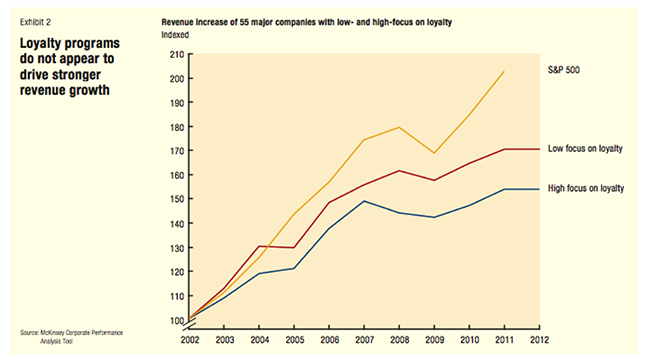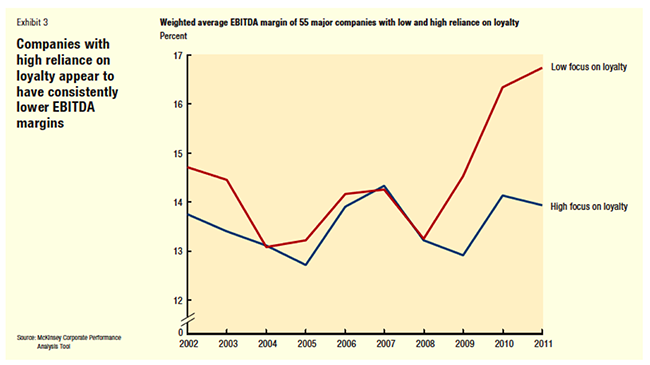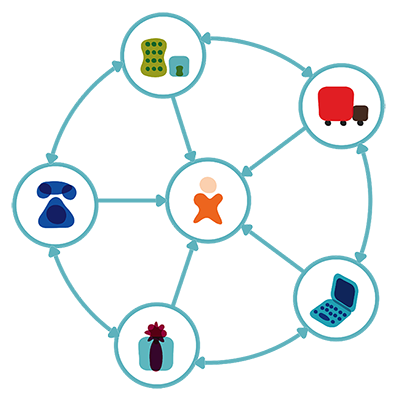
When Loyalty Does Not Pay
Transaction-based loyalty as we know it today needs to evolve into an omni-channel holistic experience.
The McKinsey Consulting study ‘Making Loyalty Pay: Lessons from the Innovators’ [pdf] blew up the idea that the existing loyalty programs pay royal dividends for retailers. Over a period of 10 years, loyalty-focused companies grew at much lesser rate, as compared to companies which were less focused on loyalty.

[Source: Mckinsey Report - Making Loyalty Pay: Lessons from the innovators-Mckinsey]
Moreover, if you thought loyalty brings in more profit, you are in for a surprise. Over the same ten-year-period loyalty-focused companies had EBITDA margins considerably lower than the companies who were less focused on loyalty programs.

[Source: Mckinsey Report - Making Loyalty Pay: Lessons from the innovators-Mckinsey]
Sounds almost unbelievable, doesn't it?
In fact another study by EKN research states that 81% of loyalty members don’t know the program’s benefits, or how and when they will receive rewards. On an average each household enrolls in around 18 different loyalty programs.
So why is this and what can retailers do about it?
Loyalty is about emotions, not about transactions
Think about all the loyalty programs you are enrolled in. How many of them offer you upgrades? How many of them offer discounts? How many of them offer exchange of products and services?
The answer is many or all of them, isn’t it? That’s the way modern loyalty programs are structured.
“You spend with us so that we can give you tools to spend more with us.”
As Doug Stephens mentions in his blog post ‘The Loyalty Lie’, this transactional nature of loyalty programs doesn’t create a gratifying experience. Most of the companies engage in ‘deal loyalty’ rather than true brand loyalty.
At the end of the day, all you get is a customer base which is so fickle that they will change the ship as soon as the next loyalty program comes along.
Retailers need loyalty programs which enhances the customer experience through every touch point and not just provide deals.
All is not lost
Having said this, there are good examples of loyalty being used the right way. One good example is the National Car rentals’ Emerald Club loyalty program. The members get benefits like: choosing any car for the cost of the reserved mid-size car, access to Emerald alerts which provides constant notifications about the rental information , access to priority queues, exclusive drop and go service, free rental days and no charge for second drivers. Moreover the Emerald Club executive and executive elite members get a guaranteed car reservation within a 24 hour notice and vehicle delivery to a lot of private airport terminals at many US national locations.
This is a true customer centric approach that strives towards identifying the potential pain points in the entire car rental lifecycle and tries to alleviate the same. The focus here is not about increasing revenue for National Car but towards creating a better experience for the customer.
The hallmark of any great loyalty program is that it provides a holistic experience, be it exceptional customer service, priority treatment, free delivery or anything which makes the customer feel special no matter which stage they are in the customer journey.
Of course, that’s easier said than done for lot of retailers.
So what’s a retailer to do?
- Understand the needs and expectations of the customer.
Focus should be on creating enriching cross channel experiences and building an emotional connect with the customer through the loyalty program. To this end identify all the touchpoints where the customer interacts with the business across all the channels. Identify the potential pain points ,the opportunities available to solve their problems and delight the customer. Service design methodology and the associated tools and techniques are very useful in this regard. - Get a unified view of your customer.
Siloed systems optimized for each function makes it all the more difficult to achieve this goal. Having loyalty as yet another project in the IT portfolio will not help much to this end. What you need to have is a single consolidated view of the customer across the ecosystem. If armed with complete accurate information about the customer at each of the touch points, we can respond to their individual needs and preferences in a timely, relevant matter.

- Have a strong analytics framework.
As Thoughtworker Aaron Erickson mentions in his Insights blog,“Traits of Analytics Led Companies”, retailers need to be able to change tactics and strategies based on the data that is coming from how the customers interact with the business. Of course, this includes how the customers interact with the loyalty program as well. A strong analytics framework will go a long way in capturing this data, deriving insights out of this data and feeding it back to constantly fine tune the loyalty program.
Learn about Thoughtworks' premier North American Event Paradigm Shift: Where business disruption and reinvention converge.
Disclaimer: The statements and opinions expressed in this article are those of the author(s) and do not necessarily reflect the positions of Thoughtworks.















